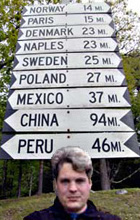Subscribe to the blog 
|
 |
 |
 |
 |
 |
Find a Flight Consider a Consolidator Rent a Car Pick a Railpass Book a Vacation Reserve a Room Get Gear |
|
||||||
|
Etna Etna is big. I remember looking for it on my first visit to Sicily about two months after I turned 12. I had been asleep in the back of the hippie-orange VW camper van that morning, and woke up when we were skirting the famed volcano. As I rubbed my eyes and poked up to the front seats, my parents reported, "Look, we're passing Mt. Etna!" Excited about the prospect of beholding a bona-fide volcano as would be any 11-year-old boy from suburban Philadelphia whose only previous experience with the primal forces of planet Earth was surviving a miniscule earthquake that would have made Richter laugh and refuse to rate it, I peered eagerly out the window at the stormy-looking sky to our left. After a few frustrated minutes, I complained I couldn't see the volcano. "It's right there," my dad pointed. I peered again into the dark blue-gray horizon, trying to pick out the mountain. Then it hit me. That wasn't the horizon. That was the volcano. Now, an undefined number of years later, I was ready to hit Etna again, having in the interim become sufficiently proficient in the field of visiting volcanoes — after all, I've now bathed in the bubbling mud pits of Vulcano, haven't I? I've watched Mt. St. Helen's billow ash on TV, haven't I? I've even gone so far as to climb to the top of Stromboli, Europe's most active volcano, and spent the night huddled in my parka against in the freezing rains and whipping winds on its summit watching its explosive eruptions periodically light up the night sky, haven't I? So after slipping along the Riveria dei Ciclopi for a stretch — a cluster of fishing villages prefixed "Aci" marked by a series of upright offshore rocks that myth holds Polyphemus the Cyclops tossed after Odysseus as the hubric Greek taunted him from his getaway ship — I turned inland for the torturous road up Mt. Etna. As high as I could drive, there was a cable car station, which I took up to a refuge perched in the midst of the weird scorched lunar landscape of the mountaintop. I spent an hour clambering and sliding around the pumice slopes (which looked like nothing so much as an endless quarry yard's gravel piles) picking out the two best volcanic bombs, one for me, one for my dad. Bombs are extremely heavy, vaguely ovoid stones formed by blobs of molten magma that once spurted out of the volcano and then cooled as they flew through the air. Then it was time to board a sort of off-road minibus with a motley group of travelers from all corners of Europe to go even higher. A bit farther up Etna, we stopped, piled of the bus, and gathered around a paunchy guide with a sunburned face and bushy mustaches who took up as high as was considered safe o that day. He reeled off his tour guide spiels in Italian, and I translated into English for everyone, who then turned to their families or little group and re-translated into French or Swedish or whatever. At the end of the little tour, back at the guides' hut-cum-bar, the guide treated me to an espresso and a shot of volcano-grade pepperoncino-laced liqueur to thank me for the collaborative effort. I feel it is important at this juncture to point out that Etna is not, technically, a volcano. Etna is a mountain. "Etna" is also the name of a huge eruptive system underlying that big mountain, which was itself formed by said volcanic activity. There happen to be four active craters around Mount Etna's summit, but these operate independently of one another and so don't constitute a single volcano. Their magma and gas systems are related, but not interconnected per se. If they were, and all of Etna at once gave a fit — as its individual craters are prone to do on occasion — with all the craters and system working in synchronization, Sicily would, basically, cease to exist. more >> |

